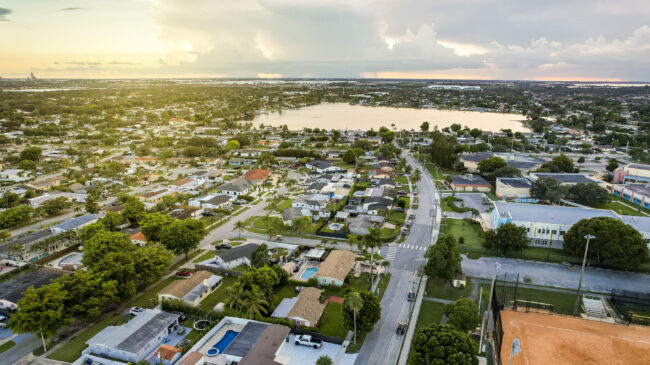Overly restrictive local zoning laws that block the development of new housing have been a problem in many states, including Florida. By limiting the types of housing that can be built and requiring larger lot sizes, Florida’s zoning laws artificially decrease the amount of housing that the market would support. With home ownership out of reach or a growing number of Floridians, it is important for elected officials to help solve this policy problem.
In 2023, Florida’s legislature took an important first step, passing a bill incentivizing private developers to create more affordable housing in order to help manage the state’s population growth. Among its funding increases and tax credits, Florida Senate Bill 102, the Live Local Act (LLA), exempts developers building affordable housing from municipal zoning ordinances and density restrictions while granting them tax breaks. The bill also reduces local planning commissioners’ authority to regulate eligible affordable developments.
Local governments’ responses to the law have been mixed. While some Florida counties have seen these changes as favorable, many have complained that the state legislature is overstepping its authority. Many municipalities have pushed back and countered the Live Local Act with new development restrictions.
For example, the city of Doral introduced a six-month moratorium to block affordable housing developments. This opposition to SB 102 changes has extended to other suburban areas like Pasco County, which is threatening to sue developers for ignoring local zoning ordinances and construction regulations.
This year, the state legislature was lobbied by municipal governments hoping to dilute some of the reforms. On Feb. 7, the Florida legislature unanimously passed Senate Bill 328, hoping it would reduce some local government’s concerns about being preempted by the state on zoning laws.
Provisions in SB 328 promote investments in affordable housing with fiscal and procedural incentives. The bill features four major incentives for real estate developers: a property tax credit, a sales tax reimbursement on the cost of materials, an exemption from local zoning restrictions, and reductions in construction red tape.
The bill says developers are entitled to tax benefits if they build 40% of their units as rentable and affordable (a minimum of 10 affordable rental units). These provisions use reduced building expenses to incentivize building developments in a traditionally less profitable housing market. Since the original Live Local Act passed, dozens of developers have submitted applications to create eligible affordable housing projects. As Reason.com’s Christian Britscghi described it, “The law is mostly a grab bag of mortgage subsidies and developer tax credits. Tucked inside is a provision allowing developers to build housing in commercial and industrial areas, provided they include a set percentage of affordable housing.”
While far from ideal, the LLA protects developers from more onerous mandatory municipal inclusionary zoning policies. In various Florida countries, developers are mandated to set aside a certain percentage of their units for affordable housing. Instead of forcing the development of affordable housing units, the Live Local Act encourages developers through incentives to set aside units for affordable housing. Although many may understandably argue this oversteps local authority, it reestablishes a choice for developers not found under municipal inclusionary zoning protocols.
While there is a concern that property owners could use affordable units for public transient lodging, precluding home buyers from purchasing them, the amendments in the newly updated bill try to minimize that possibility by using third-party appraisers to determine which properties are eligible.
While the Florida bill addressed the biggest problem for developers, reducing the minimum number of units for tax eligibility, it failed to address the major grievances of municipal governments. The state still preempts local authority for height, density, rent control, and zoning. So, many of the quarrels local governments had that this amendment intended to address were not resolved.
Most of the outcry from Florida’s local governments stems from the nullification of their zoning authority. “The Live Local Act does more to pare back local zoning restrictions than basically any recent reform passed in the nation,” Britscghi writes.
One of the concerns local governments have is that they won’t be able to control their skylines, which they fear could become overwhelmed with development projects. High-income, tourism-heavy areas such as Ocean Drive in South Beach claim that the city needs a certain aesthetic look. However, there is no peer-reviewed research that supports this claim.
While zoning ordinances are controlled by the local government, they are not inherent authorities. Instead, the state government allocates these powers to municipal governments. The state maintains the right to consolidate authority if the municipality is not properly addressing the issue. Given the strain on housing, the state recognizes housing as a bigger priority over property values and aesthetics.
Aside from the major issues local governments have, much of the conflict caused by the Live Local Act comes primarily from NIMBYs (not in my backyard). Although many NIMBYs worry about the changes potentially reducing property values, those concerns are likely misguided. Some reports find that the development of affordable housing in vibrant and healthy neighborhoods has no effect on the surrounding property values.
The distribution of affordable housing only correlates to lower property values when affordable housing is in high concentration. Given that housing developments eligible for tax exemption are only required to have 40% of their units affordable (and assuming developers intend on profit-maximizing), 60% of the housing units in development would be market rate. So, the negative effect of concentrated affordable housing would likely have little to no effect on these property values.
Given the benefit of increased incentives to real estate developers, there is now a stronger motivation to increase the affordable housing supply. Although the backlash from Florida’s municipal governments may stunt the development of these housing projects in the short term, the state government should uphold its preemption and continue incentivizing affordable housing development.
